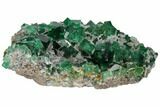This Specimen has been sold.
4.4" Rogerley Fluorite and Quartz Association - Rogerley Mine
Here is a nice 4.4" cluster of Rogerley fluorite that is encrusted in microcrystalline quartz, collected from the famed Rogerley Mine in County Durham, England. This particular kind of fluorite is unique in that it will actually fluoresce a beautiful purple-blue color in just natural light alone! Under short and long wave UV, these crystals fluoresce a vibrant purple color.
It comes with an acrylic display stand.
It comes with an acrylic display stand.
The Rogerley Mine is located in the historic Weardale mining District of Northern England. First discovered in the early 1970s, the Rogerley Mine is the only mine in all of Britain to be worked on a commercial scale in the name of collecting crystallized mineral specimens. Since the summer of 1999, UK Mining Ventures has operated the Rogerley Mine on a seasonal basis, producing many fine, well crystallized specimens of green fluorite. Rogerley material is considered some of the finest fluorite in the world, and much of it has incredible fluorescent properties under both daylight and ultraviolet light.
About Fluorite
Fluorite is a halide mineral comprised of calcium and fluorine, CaF2. The word fluorite is from the Latin fluo-, which means "to flow". In 1852 fluorite gave its name to the phenomenon known as fluorescence, or the property of fluorite to glow a different color depending upon the bandwidth of the ultraviolet light it is exposed to. Fluorite occurs commonly in cubic, octahedral, and dodecahedral crystals in many different colors. These colors range from colorless and completely transparent to yellow, green, blue, purple, pink, or black. Purples and greens tend to be the most common colors seen, and colorless, pink, and black are the rarest.
Fluorite is a halide mineral comprised of calcium and fluorine, CaF2. The word fluorite is from the Latin fluo-, which means "to flow". In 1852 fluorite gave its name to the phenomenon known as fluorescence, or the property of fluorite to glow a different color depending upon the bandwidth of the ultraviolet light it is exposed to. Fluorite occurs commonly in cubic, octahedral, and dodecahedral crystals in many different colors. These colors range from colorless and completely transparent to yellow, green, blue, purple, pink, or black. Purples and greens tend to be the most common colors seen, and colorless, pink, and black are the rarest.
About Quartz
Quartz is the name given to silicon dioxide (SiO2) and is the second most abundant mineral in the Earth's crust. Quartz crystals generally grow in silica-rich environments--usually igneous rocks or hydrothermal environments like geothermal waters--at temperatures between 100°C and 450°C, and usually under very high pressure. In either case, crystals will precipitate as temperatures cool, just as ice gradually forms when water freezes. Quartz veins are formed when open fissures are filled with hot water during the closing stages of mountain formation: these veins can be hundreds of millions of years old.
Quartz is the name given to silicon dioxide (SiO2) and is the second most abundant mineral in the Earth's crust. Quartz crystals generally grow in silica-rich environments--usually igneous rocks or hydrothermal environments like geothermal waters--at temperatures between 100°C and 450°C, and usually under very high pressure. In either case, crystals will precipitate as temperatures cool, just as ice gradually forms when water freezes. Quartz veins are formed when open fissures are filled with hot water during the closing stages of mountain formation: these veins can be hundreds of millions of years old.
SPECIES
Fluorite & Quartz
LOCATION
Rogerley Mine, County Durham, England
SIZE
4.4 x 3"
CATEGORY
SUB CATEGORY
ITEM
#132992
 Reviews
Reviews














